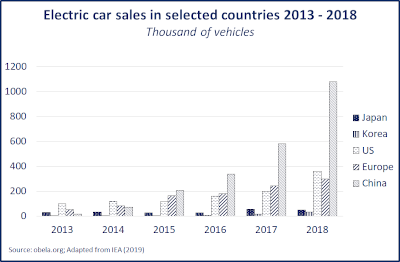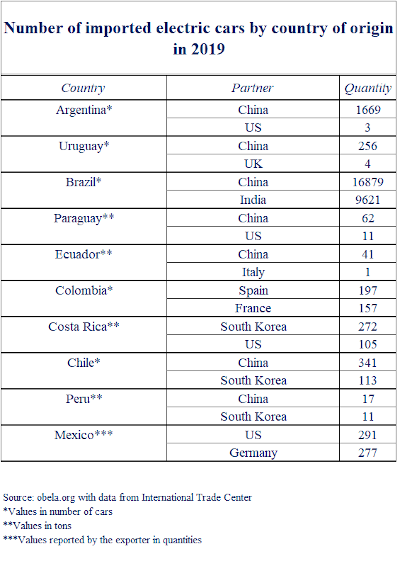Electric vehicles in Latin America
- blog de anegrete
- 8220 lecturas
The change in the energy matrix led by China is not limited to the generation of electricity through clean energy. The market for electric cars, buses, and motorcycles is booming. Since 2016 China is the country with the highest domestic sales of electric vehicles, and by 2019 it is the largest exporter of electric cars, motorcycles, and buses in the world. In Latin America, the clean transport boom is also present. Argentina, Bolivia, Brasil, Colombia, Costa Rica, Ecuador, Mexico, Peru, Paraguay, and Uruguay have a nascent market.

The world market is recent, domestic sales of electric cars began in 2005 in France and Germany, and in 2010 there were just over 9,000 electric cars in the world. The first electric car sold in China was in 2009. Only six years later, it became the country with the most electric cars in circulation, more than one million; two and a half million if we consider hybrids. The second country with the most cars on the road in the United States with 360,000 and 1 million if you consider hybrids. With a strong domestic market, China's export of electric cars started in 2017 with 109 million dollars. It is worth mentioning that in value, the United States, Germany, and South Korea are the largest exporters of electric cars. Still, in quantity, it is China, given that Chinese electric vehicles are cheaper. In terms of trade, China is not only a leader in cars. The Asian country exported in 2019: 239,653 cars, 1,520 buses and 13,346,466 motorcycles, all-electric. In comparison, the second place of each product: the USA exported 198,770 cars, 869 buses, and Belgium, 937,963 motorcycles.

In Latin America, the electric car market is emerging. To reduce the carbon footprint, the governments of Latin American countries implemented measures to stimulate the consumption of electric cars. Thus, the states with tariff exemptions since 2017 are Argentina, Brazil, Colombia, Costa Rica, Ecuador, Mexico, Paraguay and Uruguay. In Latin America, the electric car market is emerging. To reduce the carbon footprint, the governments of Latin American countries implemented measures to stimulate the consumption of electric cars. Thus, the states with tariff exemptions since 2017 to 2018. In Peru, are there is an exemption from excise duty for new electric and gasoline cars. Igualmente, en Similarly, in Mexico, there is an exemption from excise tax if the vehicle costs less than 263,690.54 mexican pesos. For the time being, there are no exemptions or discounts for imports into Chile.
Likewise, the infrastructure of countries that grant tariff exemptions has increased since 2017. Some public electric chargers are already in place: 4 in Argentina, 200 in Brazil, 55 in Chile, 40 in Colombia, 50 in Costa Rica, 15 in Ecuador, 900 in Mexico, 10 in Paraguay, and 47 in Uruguay. On the other hand, there are 3 Latin American electric cars: a Bolivian manufactured by Quantum, a Brazilian made by Santa Catarina in collaboration with Mobilis, y the Argentinean manufactured by Sero Electric. Also, in Mexico, it was mentioned in 2018 that the JAC company plans to build a factory for electric vehicles in Hidalgo and while continue selling light electric cars to Bimbo.
On the side of electric buses, governments are making efforts to electrify mass transport. This type of vehicle, in useful life of 12 years, has a lower cost of energy and maintenance in approximately 12.5% than a diesel one. China, as the leading exporter of electric buses, finds a market in Latin America due to the new electric mobility policy. Chinese electric buses are already circulating in the cities of Santiago, Medellín, Cali, Lima, Guayaquil and Mexico City y son marca BYD, Yutong y Sunwin. Chile imported 265 Chinese electric buses in 2019, making it the world's largest purchaser of the vehicle in the Asian economy. Most of them are the BYD brand and will serve to modernize the mass transportation fleet. At the moment, there are only tariff exemptions in Chile and Argentina. On the other hand, in Costa Rica, it is planned that in 2020 the electric fleet will be expanded in 12 routes in the centre of San José. There are also tests in Havana, Buenos Aires, Sao Paulo and Montevideo.
Electric motorcycles are a mobility alternative that, unlike conventional ones, do not generate noise. A bike with a range of 240 km in China does not exceed 10,000 dollars. At the same time, an American one of the same characteristics costs more than 20,000 dollars. For this reason, most of the imports in the region are of Chinese origin. Brazil is the leading importer of electric motorcycles in the area since, in 2019, it imported 193,106, followed by Chile with 178,606, Mexico with 94,718, Uruguay with 78,869 and Colombia with 68,702. On the other hand, the Salvadoran company éGOAL Electric began to import from China to sell electric motorcycles in El Salvador, Costa Rica, and Honduras.
Finally, a process of change of the automotive plant in Latin America develops, primarily led by China and although small is accelerating. The replacement of horsecars by gasoline cars occurred between 1908 and the end of World War I. Within a decade; horsecars were obsolete. This time around, the difference is that these products have the opposition of the U.S. government. The resistance is because they are vehicle competition and because they run on electricity and not gasoline, which is the country's main export. Finally, because they are of Chinese origin, a country seen as its main rival for world leadership. Official pressure against their use can be expected, if the Huawei case is an example of the recent US trade policy.